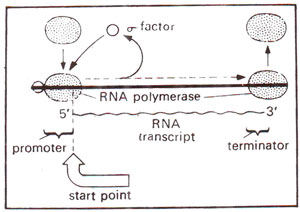
Fig. 32.5. A transcription unit, showing promoter region, start point and terminator; also shown is the role of RNA polymerase with its core enzyme and sigma factor.
For synthesis of RNA on DNA template, there are transcription units, each having a starting point and a termination signal (Fig. 32.5). It is not necessary that the RNA may be released at the termination signal, since there are situations where transcription may continue beyond the termination signal, due to anti-terminator molecule (as in lambda phage). Upstream (before start point) or down stream (after start point) to the start point of a transcription unit, there is .always a DNA sequence, which is necessary for the transcription to start. This is called a
promoter site, which is
cis-dominant or cis-acting, since it is not involved in the synthesis of any diffusible substance. It means that the promoter site should be physically continuous with the transcription unit to be transcribed and can not function if present on another chromosome within the same cell.

Fig. 32.5. A transcription unit, showing promoter region, start point and terminator; also shown is the role of RNA polymerase with its core enzyme and sigma factor.
The binding sites for RNA polymerase enzyme lie within the promoter sequence and may be 41 to 44 base pairs in length in
E. coli, where more than 100 promoters have already been sequenced. There is hardly any long conserved sequence over majority of the promoter regions, although short sequences within the promoters are conserved. The start point is a purine in over 90% cases and upstream from this start point is a 6 bp region (TATAAT), which is called
Pribnow box and is available in almost all promoters. The conservation of these six bases varies from 45% to 96% as represented by the subscripts in the following sequence (the Pribnow box for
lac operon in
E. coli is TATGTTG; see next main topic).
T80A95T45A60A50T96
The centre of Pribnow ,box lies usually 10 bp upstream and therefore it is sometimes described as -10 sequence (although the actual centre varies from -18 to -12). There is another sequence (T
82T
84C
78A
65C
54A
45) lying -35 bases upstream and is called recognition region. Although details of binding reaction are not known, typical promoters in
E. coli use -35 and -10 sequences to be recognized by RNA polymerase (Fig. 32.5). It is obvious thus, that a typical promoter in bacteria has three components : (i) consensus sequence at -10 bp; (ii) consensus sequence at -35 bp, and (iii). start point.






